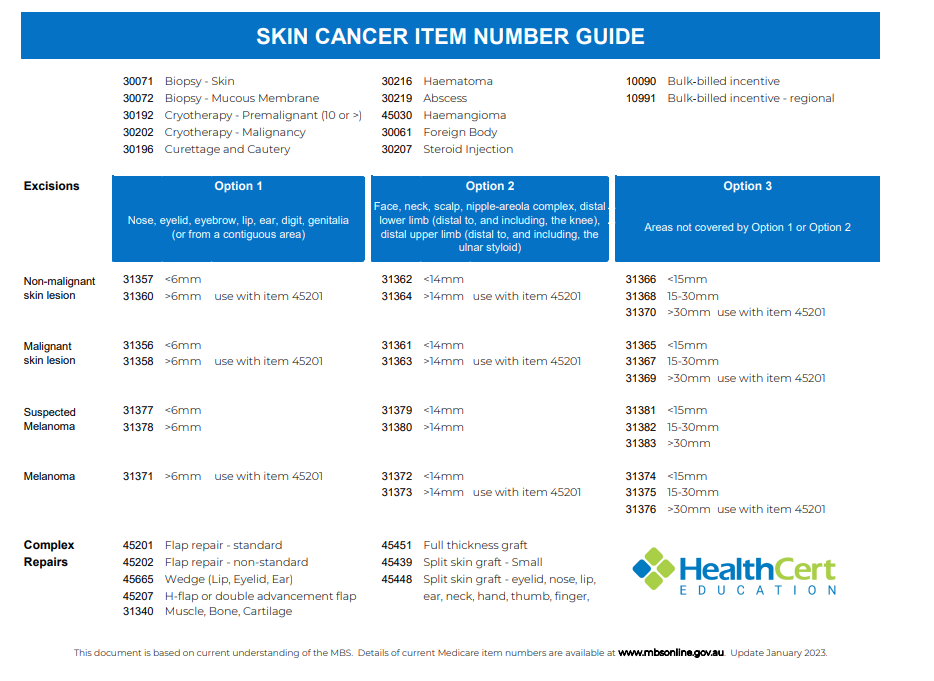
This guide explains the correct application of Medicare Benefits Schedule (MBS) items for skin biopsies, skin lesion treatments, and procedures. It also ensures that healthcare providers bill accurately and follow Medicare regulations. Proper billing requires familiarity with the specific MBS item numbers, associated descriptors, and relevant clinical indications. Following these guidelines carefully ensures compliance and avoids potential billing errors.
Note: This guide provides an overview; however, clinicians must review each item code with the Department of Health and Aged Care and ensure proper evaluation of the billing practices associated with specific codes.

Billing or claiming skin service items requires specific guidelines you need to follow. These can include but are not limited to:
Determining lesion size to identify MSB item code for excisions
The necessary excision diameter (or defect size) includes the size of the lesion along with a clinically appropriate margin of healthy tissue to ensure complete surgical excision. Measurements should be taken before the excision, and the margin size should be determined according to the current NHMRC guidelines.
Histological examination
Most skin lesions require copies of histological reports for proper code identification to ensure accurate billing. Codes 31206 to 31225, 31340, 31357, 31360, 31362, 313564, 31366, 31368, and 31370 require a specimen to be sent for histological examination. The remaining codes have further requirements or case-specific guidelines and histological confirmation of malignancy with a specialist dermatologist or plastic surgeon.
Further details can be found on the histology examination requirements for specific codes here.
Keeping evidence
All clinicians are required to maintain all records, including copies of histological examination reports, supporting documentation, and detailed patient notes. These records are essential for ensuring continuity of care, facilitating accurate billing, and providing legal protection in the event of audits or disputes.
Proper documentation also aids in tracking patient progress and supports informed decision-making in future treatments.
This category covers:
The areas of the body this category covers are:
Associated Codes: 31357, 31356, 31377, 31378,
Codes to use with 45201: 31360, 31358, 31371
This category covers:
The areas of the body this category covers are:
Associated Codes: 31362, 31361, 31379, 31380, 31372
Codes to use with 45201: 31364, 31363, 31373
This category covers:
Associated codes: 31366, 31368, 31370, 31365, 31367, 31369, 31381, 31382, 31383M 31374, 31375, 31376
Codes to use with 45201: 31370, 31369, 31376
This category includes all areas not covered by Category 1 or 2.

Certain codes fall outside the standard categories and require careful analysis to ensure accurate billing. These cases include complex cases of malignant melanoma, appendageal carcinoma, malignant connective tissue tumours of the skin, and Merkel cell carcinoma of the skin. Below are some codes associated with these conditions.
Be aware of the changes to melanoma services from 1 November 2022, including the introduction of seven new MBS items for excisions of clinically suspected melanoma; it’s essential that clinicians understand these amendments to claim melanoma excision services accurately.
To identify which item code to use for Medicare billing purposes, we recommend using Services Australia MBS billing for skin lesion treatment and biopsy items database.
Stay up-to-date with the latest information on melanoma services, including changes to MBS items and fees. These are available at www.mbsonline.gov.au


If you need to have skin cancers removed, or are concerned about some potential skin cancers, don’t delay. Book an appointment at one of our four locations today and take care of your health for the long term.